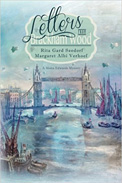
 |
Letters From Brackham Wood: A Moira Edwards Mystery
by Rita Gard Seedorf and Margaret Albi Verhoef
Cozy Cat Press
Progress giveth and progress taketh away. While electronic mail provides virtually instantaneous communication, its reliance on brevity, cyber-speak, and emojis too often eliminates that which written letters are most impactful at providing. Thankfully, the qualities of comprehensiveness, thoughtful conversation, and the ability of words rather than pictures to compellingly convey emotion are all on display in this novel woven almost entirely from shared correspondence.
Epistolary novels are not new. Bram Stoker’s horror classic Dracula was penned as a series of letters, diary entries, ships’ log entries, and more. Alice Walker’s 1983 Pulitzer Prize winning novel The Color Purple featured a series of letters a poor girl writes to God. More recently, Stephen Chbosky’s The Perks of Being a Wallflower used the literary conceit of a young boy writing letters to an unknown recipient. Seedorf and Verhoef have employed their letter-writing technique to cover one of the twentieth century’s most volatile times, and in so doing have created a very intimate portrait of what it was like to live through an extraordinarily harrowing period.
From 1937 to 1944, two cousins exchange letters that give readers a view of World War II that is rarely chronicled. Rather than missives from soldiers on the battlefields, these letters are messages from two women on separate home fronts. One is a well-educated and accomplished physician in the State of Washington. The other is a less fortunate housemaid in a small village in England. They were close in their youth, but time and circumstance separated them. Now, the greatest conflict that the world has ever known may well prove the catalyst that will unite them once again. Each of the two women’s different perspectives is rivetingly conveyed via the words they share with one another. Moira sees the specter of nationalism gripping Europe and eventually writes while under siege from German bombers. Margaret corresponds from a country that almost seems immune to fear and depravation—until the Japanese bomb Pearl Harbor and America enters the war.
Authors Seedorf and Verhoef have woven an engaging tapestry of interpersonal communications that pull readers not only into the horrors of war but also into the simple pleasures of sharing hope, fear, and aspirations. While the cousins may be miles and oceans away from each other, their bond is forged with the words they share. From their letters, readers experience the differences and similarities that were lived by millions of people charged with much more than keeping the home fires burning, for Moira and Margaret’s story transcends sacrifice. The book is also a literate canvas of spirit, resolve, and accomplishment. There’s even a thoroughly engaging and believable mystery entwined within the passages these loved ones exchange—a mystery that remains unsolved until virtually the novel’s end.
Seedorf and Verhoef have created an excellent tome that will enthrall most readers not merely with its content but with its style and construction, as well. There are some who say the best writing should simply sound like one person talking to another. This book is a rather exceptional example of that.
RECOMMENDED by the US Review